by Sandra Gulland | Oct 18, 2014 | Adventures of a Writing Life |

Revision is daunting, and each revision is daunting in it’s own way. It always feels like a strange and unwieldy process. How to begin? Where to begin?
I began by making a list:
- easy changes
- harder changes
- hard changes
When starting out, it’s best to begin with easy changes, and work up to the more challenging ones.
I was stopped in my tracks at the first heading. What was the name of Hortense’s school? What was it called at the time?
This simple question plummeted me into Google-land research, which, in the way of the Net, opened up wondrous worlds.
Then, of course, I was compelled to post to my research blog, Baroque Explorations:
Handwriting samples: Napoleon’s, Josephine’s, and that of Christophe Duroc.
On-line research: subscription publication—an 18th century method of fund-raising?
Yes, a form of procrastination, I know.

It just now occurred to me that my deadline is five weeks off, and that I am travelling for most of it.
Full stop.
I believe it time for me to make a list of essential changes, never mind easy, harder and hard.
As Napoleon would say: Basta! Get to work!
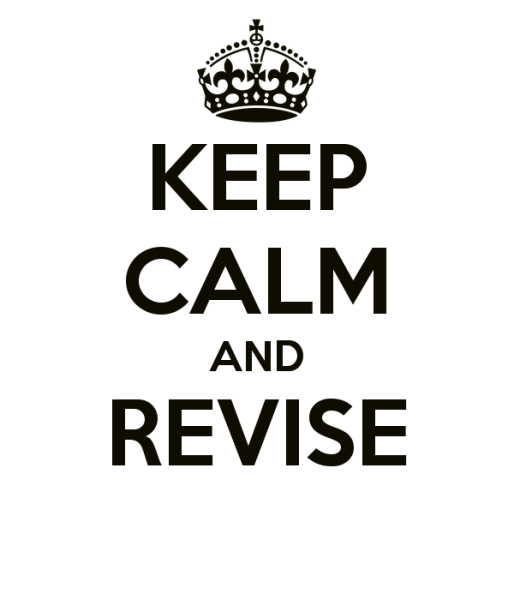
by Sandra Gulland | Oct 1, 2014 | Adventures of a Writing Life |
My husband and I have been over two weeks in Paris, and today is our last day here. 
I’ll be spending much of it in the library of La Fondation Napoleon, but I’m tempted to slip in an hour as a flâneur this morning, strolling the book stalls by the Seine … and perhaps even take some photos.
I’ve not taken many, in part because it has been very much a working trip.
For the first two weeks I was in class at l’Alliance Française Paris.
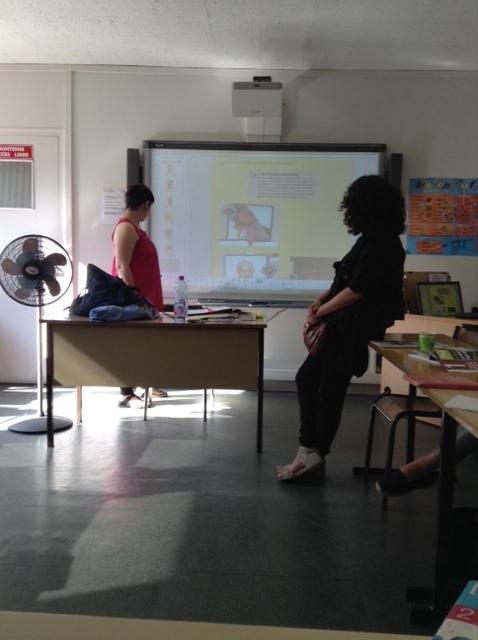
At level B1, I was in way over my head, but the teacher was fantastic, very charming, and so I persevered—and I’m happy I did so. I’m less shy now about speaking French, and in another ten years … who knows? By the time I’m 80, I might be able to understand what people are actually saying.
In any case, I was absolutely enchanted—besotted!—with the teacher’s Smart Board. This technology is years old, but it blew me away. I had no idea! On a Smart Board a teacher can move images around, write, move words, scroll, call up videos, play audio, switch between pages, connect to the Net: anything.
Immediately I thought: every home needs a Smart Board. More to the point: I need a Smart Board. Imagine outlining a novel on it, calling up character images … ! Seeing a Smart Board, I felt the same kind of revery I experienced first seeing a computer. What a tool!
When I wasn’t in class or frantically preparing homework (or eating fine food and drinking fine wine), I plunged into research. Our first weekend in Paris it was the Journées du Patrimonie, when many historic places are opened to the public. I wanted to see inside the Petite Luxembourg Palace, where Josephine, Napoleon and “the kids” — Hortense and Eugène — lived before the move to the Tuileries.
The lines and crowds were overwhelming, and the public was only allowed into a few rooms of the Petite Luxembourg, but I did see the room believed to be the one Napoleon worked in.
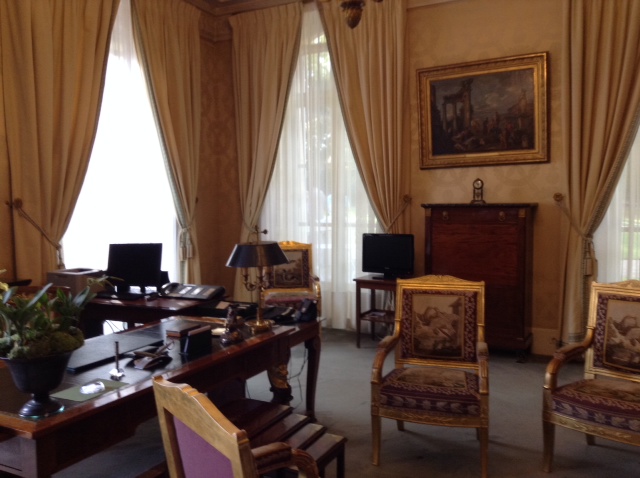
Of course, it would have been a bit thread-bare then.
The Luxembourg palace itself is, of course, amazing. Here, the library:
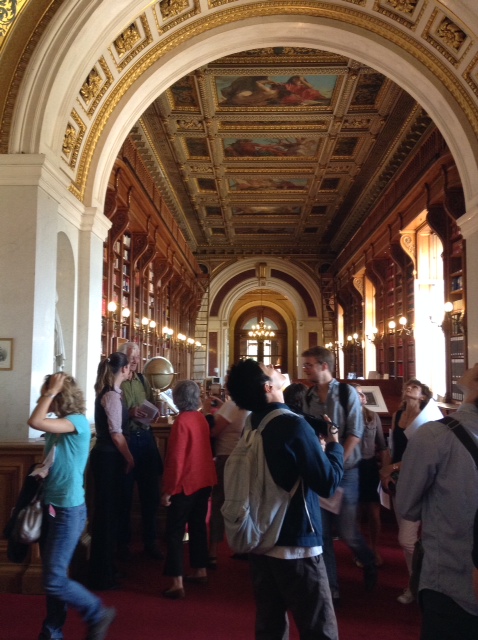
It would have been quite a bit different just after the Revolution, of course. It had been used as a prison, and had no doubt been vandalized.
Also around Paris, I searched out sites:
—the location of La Chantereine (discovering how very long the lane way must have been);
—where the mother of a character killed herself during the Revolution;
—where Talleyrand lived (and gave a ball);
—where Napoleon’s brother Lucien Bonaparte lived (and likewise gave a ball).
And, of course, the Louvre, where I lingered by portraits of my characters.
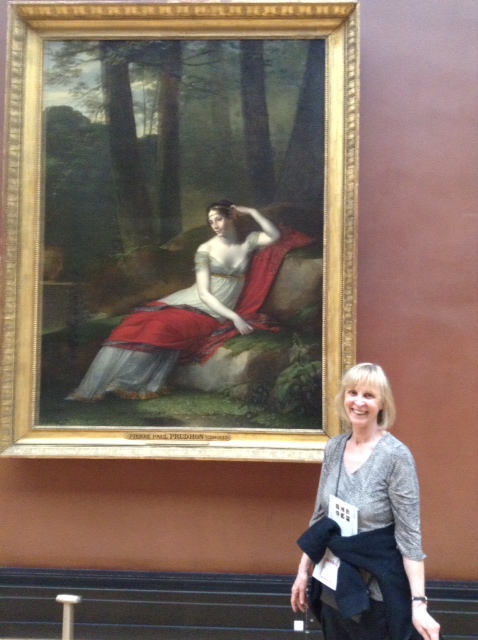
I loved seeing the glittering detail of Josephine’s gown up close:

Venturing out-of-town, we went to Château de Grignon, the home of Hortense’s best friends (and now a school)…
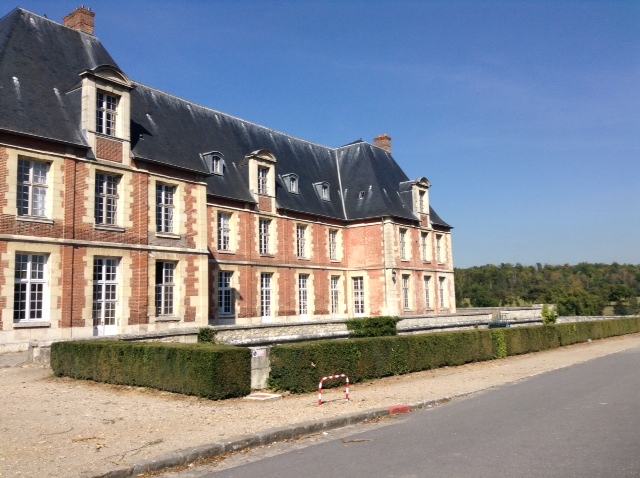
… and to Joseph Bonaparte’s country château Mortefontaine, where I was very very lucky to connect with the owner and be given a private tour.

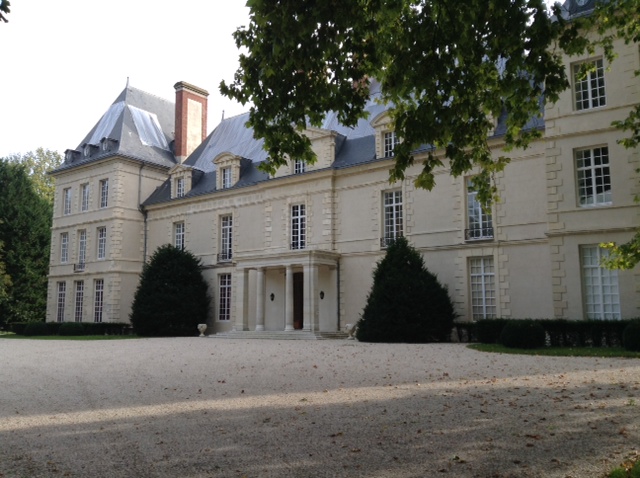
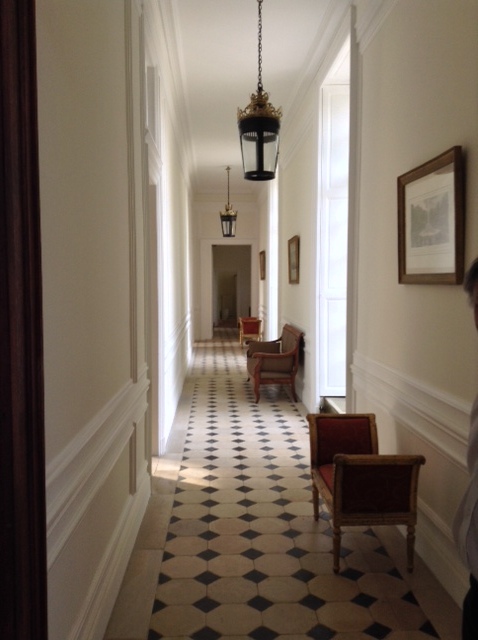
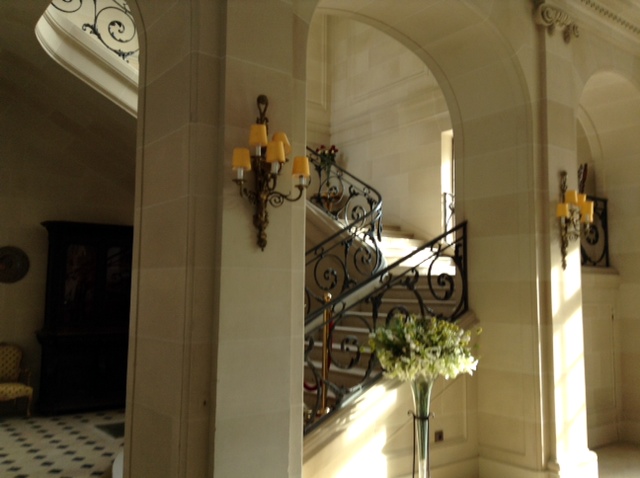
Last, we went to Saint-Germain-en-Laye where I was again very lucky that a former resident was kind enough to show us into the place where Madame Campan’s school used to be. Much of it is new, but there are some remnants of the former Hôtel de Rohan:
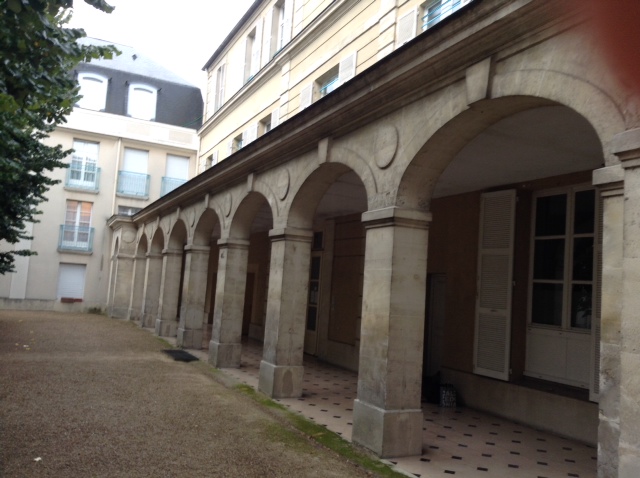
In the back garden, there was this intriguing bit of antiquity:

A bit of the former chapel, perhaps?
Of course, as is always the case with travel research, I discover that I have quite a few changes to make in the next draft, which I will begin next week. But until then, time to flâneur.
by Sandra Gulland | Jul 28, 2014 | Baroque Explorations |
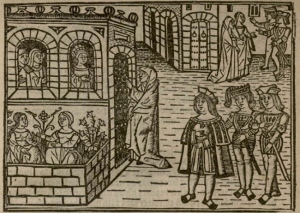
A blog post on Medievalists.net—Medieval Mean Girls: On Sexual Rivalry and the Uses of Cosmetics—reveals a treasure trove of diaries about the jealousies and beautification efforts of women in the late Middle Ages. It is fair to assume that such rivalry continues on through time.
Consider:
- Lipstick: red dove feet mixed with brazil wood and alum
- Toothpaste: nutmeg
- Nail polish: henna
Here are some priceless quotes:
Is there here any lady among us who does not wear cosmetics or cream on her face, or uses depilatories, or cara de diable? How they sorrowfully take off that cream, and put on snake and lizard water. Oh, they sin greatly those who act so vainly, in order to please men.
Well, does she wear white powder on her face? Truly, up to her eyes! And, blush? In excess! Her eyebrows [are] well tweezed, high and arched, her eyes made up. Her forehead [is] scraped clean, and even her entire face –the big and tiny hairs– with pelador de pez, turpentine, and chamomile oil. Her lips [are] very red, not natural but from red dove feet mixed with brazil wood and alum. Her teeth were brushed with nutmeg or scrubbed with styrax, an herb from India. Her nails [are] stained with henna and grown long, longer than those of her pinkies, also stained white, and she even covers them with gold. Her face [is] shiny like a sword […]. She puts ten different foundation creams on her face, one after the other, once each day, and when she doesn’t have them on she looks like an Indian heathen.
All the year long she is mewed up at home … she anoints her face with gall and honey, with parched grape and figs crushed and pressed together … … she has such breasts, being a maid, as if she had been the mother of three children; and are for all the world, like nothing more than two great pompeans, or big bottled gourds. Her belly I have not seen, but judging it by the rest, I verily believe it, to be slack and as flaggy, as a woman of fifty year old. She had a room full of distillation vessels, wide mouthed and narrow necked flasks made of clay, glass, copper, or tin, made in a thousand different ways. She made sublimate, cooked-up make up, face-paints, lipsticks, llanillas, lotions, waters to make the face glisten, to cleanse the skin, alvalines, and other tonics, made of shavings of daffodil, wood bark, cittibush, tarragon, galls, sour grapes, [and] grape must, distilled and sweetened with sugar…
Whoever wishes one’s face to be beautiful should constrain the blood from flowing towards it. With wine and food both subtle and tasty, the fig in this case is wonderfully good, as is date water and honeyed foods. And if from chicken pox one’s face is marked, use an ointment from cheese, honey, and salt. And an ointment of cetrina [cerrusite, camphor, and oil mixed with citron] is very good for this. And if one has freckles or discolorations on one’s face, a myrrh wash is beneficial.
by Sandra Gulland | Jul 27, 2014 | Adventures of a Writing Life |

George Washington studied Rules of Civility & Decent Behaviour based on a work by French Jesuits in 1595. In showing what people should not do, I find such guides helpful in defining bad behaviour. For example, based on these rules, you would:
1) be disrespectful,
2) put your hands on some private part of your body,
3) sing to yourself with a humming noise,
4) drum with your fingers or feet,
5) cough, sneeze, sigh or yawn,
6) fall asleep when others are talking,
7) spit into the fire,
8) gnaw your nails,
9) bedew someone’s face with your spittle,
10) kill fleas or lice ticks in company,
11) turn your back to someone who is speaking,
12) puff up your cheeks or loll out your tongue,
13) read letters, books or papers without asking leave,
14) laugh too loud and too much at a public spectacle,
15) look men of quality full in the face,
16) run in the streets with your mouth open,
17) ask someone how they came to have a blemish,
18) laugh in the presence of a superior,
19) scratch, spit, cough and blow your nose at table,
20) use your greasy knife to take salt or cut bread,
21) blow on your hot broth,
22) spit out the stones of a fruit pie onto your plate,
23) throw something under the table,
24) drink and talk with your mouth full,
25) clean your teeth with a table cloth napkin, fork or knife.
Number 9 is especially annoying, don’t you think? And don’t you just love the word “bedew”?
by Sandra Gulland | Jun 8, 2014 | Adventures of a Writing Life |

Richard and I just returned home after a week on the road touring Montreal, Quebec City and the Eastern Townships. Quebec is such a beautiful province! We ate so well, I didn’t want to leave. (Not that we don’t eat very well at home: Richard is a wonderful cook.)
A new goal for me is to write every day, even when on holiday, so I’ve developed what I call a “Cup of Work” each morning. With my morning coffee, I put headphones on, tune in to classical, and write. (Or, as is the case right now, revise.) This way we can travel more, and I can still meet my deadlines—but most of all, I love the feel of this routine.
This morning, I finished the revisions to draft 3.0 of The Game of Hope (working title). I could now print it out and begin draft 3.1, but I think I should make a few more changes. Before we left, I put out a request for research help on the H-France chat group (a large group of historians of French history), and already I’ve had some great responses.
I’ve been meaning to post the highlights of my tour—that will come.
A delicious historical diversion: Retronaut.com, a repository of historical images.
I’ve begun reading Kate Atkinson’s Life After Life: brilliant. I usually have five or so books on the go at a time (I’m an ADD reader), but this novel deserves my full attention.



















